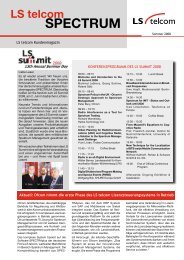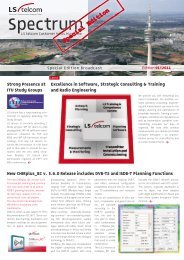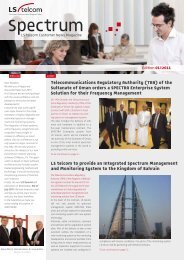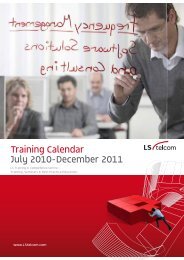LS OBSERVER - LS telcom
LS OBSERVER - LS telcom
LS OBSERVER - LS telcom
Create successful ePaper yourself
Turn your PDF publications into a flip-book with our unique Google optimized e-Paper software.
<strong>LS</strong> <strong>OBSERVER</strong><br />
Small & Smart instead of Big & Beautiful<br />
www.<strong>LS</strong><strong>telcom</strong>.com
There’s no limit to Observing the Frequency<br />
Environment – with <strong>LS</strong> <strong>OBSERVER</strong><br />
In line with the ever increasing use of wireless devices the radio spectrum is becoming congested and<br />
its value increases. Efficiency in spectrum management is key, if you want to maximise the use of frequencies.<br />
Spectrum regulators and operators alike need to permanently “monitor” the real use of the<br />
entire spectrum to identify and locate both unused, underused frequencies and interference in order to<br />
effectively manage spectrum.<br />
One of the problems of conventional monitoring<br />
systems is the question of where to locate them.<br />
In addition, traditional monitoring stations often<br />
produce too little data or have the wrong location<br />
with respect to the area or frequency monitored.<br />
Regulators set up measurement campaigns for<br />
different frequencies over a certain period of time<br />
in the hope that what they measure is needed for<br />
future policy making. But who can look into the future?<br />
Has it ever happened that the spectrum data<br />
How does it work?<br />
Store huge amount of data over a long period of time<br />
You can “observe” the complete frequency range<br />
and carry out detailed analysis on raw spectrum<br />
observation data that is stored for 30 days. The<br />
system then automatically compresses and stores<br />
the entire observed spectrum throughout the tuning<br />
range of the attached RF front, while noise and<br />
zero occupancy are removed. You can store the<br />
compressed data for about two years. Save on<br />
a costly and complex backhaul solution with the<br />
data being stored within the remote monitoring<br />
unit.<br />
ITU compatible<br />
you collected during a campaign did not fully cover<br />
the band you now need, requiring you to undertake<br />
a completely new monitoring exercise?<br />
This is where <strong>LS</strong> <strong>OBSERVER</strong> comes in.<br />
<strong>LS</strong> <strong>OBSERVER</strong> monitors the entire frequency spectrum<br />
and captures everything all the time.<br />
You can monitor everything the whole year through.<br />
Whatever monitoring data you need, you have it in<br />
your system and you can retrieve it easily for instant<br />
intelligent decision making later.<br />
Intelligent software will sort out the necessary<br />
information. Only the data required for analysis<br />
is transferred to the central server. You can retrieve<br />
exactly the data you need with the help of<br />
search filters. This is why only little infrastructure<br />
is needed to connect to the RF front end device.<br />
In addition, the transferred data is stored on the<br />
central server and, if needed once more, does not<br />
have to be retrieved again from the monitoring unit.<br />
<strong>LS</strong> <strong>OBSERVER</strong> next generation monitoring hardware and software solution is, of course, compatible<br />
with all the monitoring guidelines and recommendations in the ITU spectrum monitoring handbook.
Cost Effective Investment &<br />
No Barriers to Entry<br />
Cost Saving through Flexible Design<br />
You do not need a full network of identically specified stations. You can scale your RF front end exactly<br />
according to the capability you need and the budget you have available by choosing from a variety of<br />
receivers, sensors and spectrum analysers. The modular design with COTS products allows for easy<br />
field maintenance. You can also save on initial investment by integrating your existing system into the<br />
<strong>LS</strong> <strong>OBSERVER</strong>. Start with a stand alone system and finish with a national network by gradually building<br />
up remote monitoring units. We can change or update your RF front end to ensure a future proof network<br />
and to adapt to your changing requirements. We also build in redundancy and fail over according to your<br />
needs.<br />
Small & Smart instead of Big & Beautiful<br />
As opposed to traditional very heavy monitoring equipment, <strong>LS</strong> <strong>OBSERVER</strong> RF front end devices have<br />
a very small footprint and allow for “single pole” mounting. Permission to install these small and smart<br />
devices is easily obtained.<br />
They can literally be installed anywhere which means that many more site locations can be considered<br />
for their installation. You can use, for example, 3G or 4G sites, too. Only two people are needed to set up<br />
the <strong>LS</strong> <strong>OBSERVER</strong> device where five people are necessary to install a conventional monitoring station.<br />
Flexible Connectivity of Remote Sites<br />
The backhaul connectivity needed can be scaled to use whatever is available from low bandwidth PSTN<br />
or VSAT connection through to high bandwidth point-to-point links. No longer do you need to base your<br />
decisions on where to place a station on the connectivity available locally. As there are no special mast<br />
or other site requirements, sites can be relocated easily and cheaply. You can quickly place mobile and<br />
temporary stations, due to the low power and network connectivity required.<br />
Flexible System Configuration according to Your Needs<br />
<strong>LS</strong> <strong>OBSERVER</strong> can be used as a standalone system with simple single user access for direct user interrogation<br />
of monitoring units or in a fully redundant virtualised server environment. The central management<br />
unit manages all attached remote monitoring units’ health, configuration, security and network<br />
availability. The server-client architecture allows for integration of both desktop and remote users on<br />
either fixed or wireless connections.<br />
Top-Class Solution: Integration with<br />
Spectrum Management Systems<br />
Integrate <strong>LS</strong> <strong>OBSERVER</strong> with a spectrum management system, such as SPECTRA, for easy automated<br />
analysis of spectrum usage, automated licence and channel validation, report generation and quick<br />
identification of illegal use or interferers.
Spectrum Policy Making<br />
As a regulator you ensure that spectrum is managed and used efficiently. You have to justify to the<br />
public that people get the best from their communications services.<br />
Evidence-based Regulation<br />
Whether you need to reform your frequency plan,<br />
re-allocate frequencies or organise spectrum auctions;<br />
you need real world data to establish your<br />
business case.<br />
<strong>LS</strong> <strong>OBSERVER</strong> provides you with long-term historical<br />
measurement data for spectrum policy analysis.<br />
You are in desperate need for spectrum to<br />
attribute to a new service? Retrieve the relevant information<br />
on usage from <strong>LS</strong> <strong>OBSERVER</strong> and check<br />
whether a licensed frequency band is really used<br />
to its full extent. You may consider it worthwhile<br />
to pay to exit a user of an under-used frequency<br />
and attribute it to someone else making better use<br />
of it. Optimise frequency management and use<br />
through evidence-based regulation.<br />
Don’t miss a thing<br />
<strong>LS</strong> <strong>OBSERVER</strong> “notices” even the shortest of taxi<br />
conversations. Much faster than traditional<br />
systems that often revisit a channel only every<br />
few minutes and miss lots of transmissions. The<br />
meticulous information on real frequency use that<br />
the system provides you with, helps you clear up<br />
even the tiniest misuse of frequencies, manage<br />
frequency white space more efficiently and<br />
increase revenue from licensing.<br />
Geo-Location<br />
Correct Your Licence Data<br />
Do you agree that for efficient spectrum management<br />
and use, you need to know what’s really going<br />
on in the spectrum environment? That it‘s not<br />
enough to have a well-managed and well-functioning<br />
licence database?<br />
It is essential that your license data is accurate.<br />
Often, licence and frequency data in the database<br />
are not more than 70% accurate compared with<br />
measured spectrum occupancy. In order to increase<br />
revenue from licensing you need exact, longterm<br />
monitoring data to make sure your licence<br />
data and licensing framework is optimised.<br />
With <strong>LS</strong> <strong>OBSERVER</strong> you can measure real spectrum<br />
occupancy the whole year through. Connected<br />
to a spectrum management system, you can<br />
compare measurement data with licence data in<br />
your database and optimise your licensing.<br />
Locate illegal transmitters in cities<br />
It is in cities, where you are most in need of eliminating illegal frequency use. This is where spectrum is<br />
congested, where you have to ensure its optimal attribution and where illegal use causes greatest<br />
interference. Therefore a great advantage of geo-location over direction finding is that it enables you to<br />
locate illegal transmitters in cities and to take enforcement actions. As high buildings distract the signal<br />
from its original path, transmitters cannot be located through direction finding which is based on triangulation.
Typical Observer Network<br />
Key System Features<br />
General Features<br />
Flexible configuration, including<br />
redundancy capability<br />
Re-use existing monitoring equipment<br />
Scalable to customer’s requirements<br />
Easy to install<br />
Special Features<br />
Powerful automated analysis capability<br />
Flexible resource prioritisation control<br />
Long term monitoring data storage<br />
24 hours a day 7 days a week total<br />
spectrum storage<br />
Up to 7.5 GHz per second spectrum monitoring<br />
Sites<br />
Very few site requirements; only low power and<br />
thin back haul network connectivity necessary<br />
Small footprint installation<br />
Vehicle installation and mobile monitoring<br />
Integration of Geo-Location capability<br />
Network Management<br />
Central network management & centralised<br />
configuration of remote units<br />
Central backup capability<br />
Managed security access<br />
Integration & Interface with Other Systems<br />
Integration with <strong>LS</strong> <strong>telcom</strong> back office products<br />
Export of data in ITU formats<br />
Able to import legacy data
“Why should I monitor with <strong>LS</strong> <strong>OBSERVER</strong>?”<br />
<strong>LS</strong> <strong>OBSERVER</strong> is the next generation monitoring and has many advantages over traditional monitoring systems.<br />
What are the key differentiators of <strong>LS</strong> <strong>OBSERVER</strong>?<br />
Data Capture: <strong>LS</strong> <strong>OBSERVER</strong> captures ALL frequencies at all times.<br />
Data Storage: <strong>LS</strong> <strong>OBSERVER</strong> automatically compresses and stores all monitoring data for about 2<br />
years.<br />
Data Analysis: <strong>LS</strong> <strong>OBSERVER</strong> provides you with the data for intelligent spectrum policy analysis and<br />
evidence-based regulation whenever needed.<br />
Flexible Design: With <strong>LS</strong> <strong>OBSERVER</strong> you can scale your RF front end according to your capacity and<br />
budget needs. You can use a variety of receivers, sensors and spectrum analysers.<br />
“Will I be able to afford<br />
<strong>LS</strong> <strong>OBSERVER</strong>?”<br />
“We already have a monitoring<br />
system, but we would like to use<br />
<strong>LS</strong> <strong>OBSERVER</strong>”<br />
For further information, please visit our website www.<strong>LS</strong><strong>telcom</strong>.com<br />
or check our training calendar and product catalogue.<br />
Headquarters<br />
<strong>LS</strong> <strong>telcom</strong> AG,<br />
Germany<br />
Im Gewerbegebiet 31-33<br />
D-77839 Lichtenau<br />
Germany<br />
+49 (0) 7227 9535 600<br />
+49 (0) 7227 9535 605<br />
Subsidiaries<br />
<strong>LS</strong> <strong>telcom</strong> Limited,<br />
Canada<br />
1 Antares Drive, Suite 510<br />
CDN-Ottawa, ON, K2E 8C4<br />
Canada<br />
+1 (0) 613 228 4112<br />
+1 (0) 613 228 4113<br />
Info@<strong>LS</strong><strong>telcom</strong>.com www.<strong>LS</strong><strong>telcom</strong>.com<br />
www.<strong>LS</strong><strong>telcom</strong>.com<br />
<strong>LS</strong> <strong>telcom</strong> SAS,<br />
France<br />
4 av Morane-Saulnier, Bât. A<br />
F-78140 Vélizy<br />
France<br />
+33 (0) 1 3926 8585<br />
+33 (0) 1 3926 8586<br />
“Yes. You can start small and<br />
grow the system at your own<br />
pace and budget. Your advantage<br />
is that <strong>LS</strong> <strong>OBSERVER</strong> monitoring<br />
stations run on very low power<br />
and low bandwidth connectivity<br />
and there are few site requirements.”<br />
“You can integrate your<br />
existing monitoring system<br />
in <strong>LS</strong> <strong>OBSERVER</strong>.”<br />
<strong>LS</strong> of South Africa Radio<br />
Communications (Pty) LTD<br />
131 Gelding Ave, Ruimsig,<br />
Roodepoort, 1724 Johannesburg<br />
South Africa<br />
+27 (0) 11 958 5153<br />
+27 (0) 86 569 1419
<strong>LS</strong> <strong>OBSERVER</strong> - Technical Overview<br />
Remote Monitoring Unit<br />
RF Front end Agilent N6814E 20 MHz – 6 GHz 10 GHz / sec<br />
R&S EM100 (with FE) 20 MHz – 7.5 GHz 2 GHz / Sec<br />
Signal Hound 20 MHz – 4.4 GHz 0.5 GHz / sec<br />
Legacy monitoring interface ITU SCPI protocol (others available)<br />
Local Data Storage RAW 30 Days<br />
Compressed 2 years<br />
Power requirements 12V/ 110V /230V ±60 Watts<br />
Network requirement Minimum 9.6 Kbs GPRS /UMTS / VSAT / ADSL / PSTN /<br />
Point to Point<br />
Antenna Requirement GPS mounted on pole with receive antenna(s)<br />
Receive antenna(s) To suit RF font end<br />
Environmental Outdoor mounted IP 64<br />
Weight / mounting 20 Kgs Single 50mm Pole<br />
Central Management Unit<br />
Server requirement Processor Quad Core 2.8 GHz<br />
Client user system requirement<br />
Memory 8 Gb<br />
Storage 16 Tb<br />
Operating System Windows 7 Professional 64<br />
bit<br />
Network Connectivity Local network 1000BaseT<br />
Remote network To suite networks attached<br />
Client PC requirement Processor Dual Core 2.0 GHz<br />
Memory 2 Gb<br />
Storage 250 Gb<br />
Operating System Windows 7 Professional 32<br />
bit<br />
Network Connectivity Wired or wireless<br />
Relevant ITU specification conformity<br />
Occupancy ITU-R SM.182-5<br />
ITU-R SM.1536<br />
ITU-R SM.1793<br />
Field Strength measurement ITU-R SM.378-7<br />
ITU-R SM.1447<br />
ITU-R SM.1708<br />
Bandwidth measurement ITU-R SM.443<br />
Data Exchange ITU-R SM.1809
<strong>LS</strong> <strong>OBSERVER</strong> - Typical Observer Network<br />
“Why should I monitor with <strong>LS</strong> <strong>OBSERVER</strong>?”<br />
<strong>LS</strong> <strong>OBSERVER</strong> is the next generation monitoring and has many advantages over traditional monitoring systems.<br />
What are the key differentiators of <strong>LS</strong> <strong>OBSERVER</strong>?<br />
Data Capture: <strong>LS</strong> <strong>OBSERVER</strong> captures ALL frequencies at all times.<br />
Data Storage: <strong>LS</strong> <strong>OBSERVER</strong> automatically compresses and stores all monitoring data for about 2<br />
years.<br />
Data Analysis: <strong>LS</strong> <strong>OBSERVER</strong> provides you with the data for intelligent spectrum policy analysis and<br />
evidence-based regulation whenever needed.<br />
Flexible Design: With <strong>LS</strong> <strong>OBSERVER</strong> you can scale your RF front end according to your capacity and<br />
budget needs. You can use a variety of receivers, sensors and spectrum analysers.<br />
“Will I be able to afford <strong>LS</strong> <strong>OBSERVER</strong>?”<br />
Yes. You can start small and grow the system at your own pace and budget. Your advantage is that <strong>LS</strong> OB-<br />
SERVER monitoring stations run on very low power and low bandwidth connectivity and there are few site<br />
requirements.<br />
“We already have a monitoring system, but we would like to use <strong>LS</strong> <strong>OBSERVER</strong>”<br />
You can integrate your existing monitoring system in <strong>LS</strong> <strong>OBSERVER</strong>.











